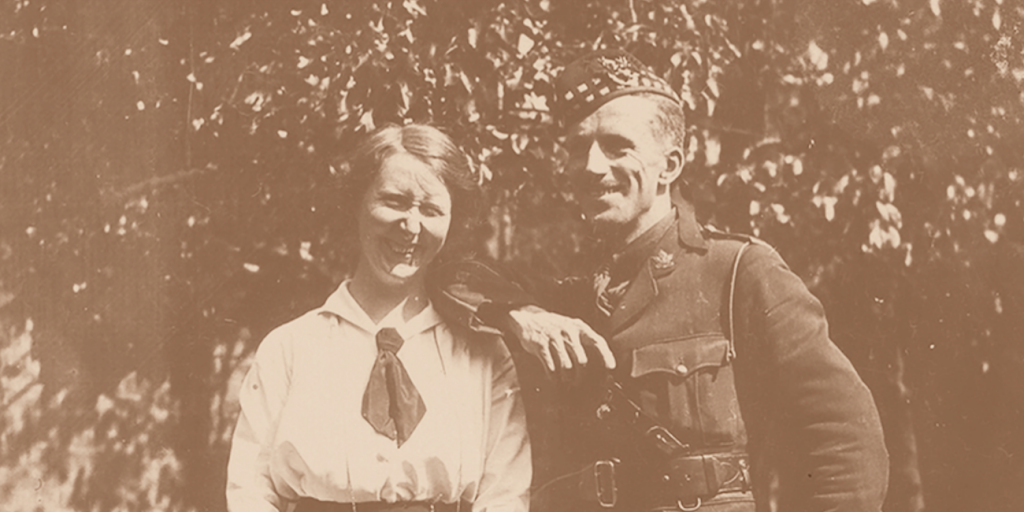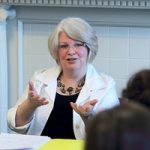Nancy Christie
What does a microhistorical approach, based upon the subjective experiences and writings of individuals, offer the history of sex and love in early twentieth-century Britain? This was the central question guiding research following the discovery, in early 2014, of the enormous personal archive of nearly 2000 letters written by a young Canadian, Harry Logan, and his British fiancée, Gwyneth Murray. Here was a source, buried under an anodyne description in the Library and Archives of Canada, that historians of love, gender, and sexuality dream of having: a set of first-person documents that detailed the engagement, troubled courtship, marriage, and intense wartime sexual relationship of Harry and Gwyneth between 1911 and 1919. The letters reveal intense and often debilitating introspection, personal struggles over gender roles and identities, and the joys the couple encountered through the practice of a wide variety of sexual roles, positions, and techniques.

From the outset, our (Nancy Christie and Michael Gauvreau) research faced a central tension. Does the experience of a fairly conventional, middle-class, heterosexual Edwardian couple have anything new to say about sex and love in Britain? Harry Logan was the son of a prominent Canadian Presbyterian minister. After undergraduate studies at McGill, he attended Oxford University on a Rhodes Scholarship between 1908 and 1911. When he became engaged he aspired to follow his father’s vocation. Gwyneth Murray was the youngest child of Sir James Murray, founding editor of the Oxford English Dictionary. After study at the Oxford High School for Girls she entered Girton College, Cambridge in 1909, graduating in 1912 with a First in Maths and Physics. Rich though the personal archive left by Harry and Gwyneth is, are they in any way representative of young men and women who lived through a period of accelerated sexual and cultural modernity?
During the past two decades, historians of twentieth-century Britain have delineated the landscape of a “modern sexual and gender regime”, forged by encounters of the educated classes with psychological and medical knowledge and, above all, with the new science of sexology. Its dominant characteristics were increasingly fixed and essentialized gender identities, the “normative” nature of heterosexuality and the deviancy of same-sex relationships, and the increasing conjunction between love and sexual pleasure for both women and men. This view has now achieved the status of a master-narrative, one linked to the story of modernity itself. Its central lynchpin was the First World War, which broke down the remaining barriers of Victorian convention, validated the experience of creative minorities like the Bloomsbury Circle, and spawned classics such as Marie Stopes’ Married Love (1918), regarded as the manifesto of the new British regime of love and marriage. Over the intervening two decades these notions trickled down to the British working classes and, though interrupted by the parenthesis of World War II, marked a linear progression towards the great sexual liberalization of the 1960s.
In confronting this historiographical and theoretical landscape our study of Harry and Gwyneth adopts the optic of microhistory, though with one major modification. According to its exponents, microhistory shifts the scale of inquiry from large-scale questions inspired by social-science methodology to the local, the particular, and the individual, in the belief that this will reveal what is frequently overlooked in grand narratives. This shift in optic enables historians to avoid the classic riposte of older social history practices, that their subjects are not “representative” of society or social trends as a whole. The best of these histories, often working on themes in medieval and early-modern history, uncover what may seem exceptional, marginal, exotic, or remarkable, the study of which, its advocates insist, enables historians to rewrite accepted grand narratives.
Unlike the tricksters, heretics, suspected witches, and cunning peasants who inhabit most microhistories, however, Harry and Gwyneth were, on the surface of their lives, remarkable only for the scope and extent of their personal archive. However, the remarkable content of their letters, revealing an unexpected range of gender fluidity, cross-dressing, mild sado-masochism, same-sex desires and passions, and awareness of child sexuality, to say nothing of sexual practices encompassing a variety of positions, oral sex, and the playful adoption of the psychological personae of a penis (Peter) and a vagina (Dardanella) during World War I, compels historians to ask the question: can there be a microhistory of the normal and conventional?
In answering the question in the affirmative this book expands the agenda of microhistory to include the modern era, and contends for the need to encompass the lives and experiences of what at first glance might appear to be conventional individuals. It offers insights, from the subjective lived experience of individuals, that take a fresh look at the advent of the modern sexual regime in Britain in the early twentieth century, and revises the master narrative in several important respects. First, a major assumption of many works in the history of sexuality has been the privileging of the discourses generated by medical professionals and sexologists in the making and dissemination of new sexual and psychological knowledge. Although Harry and Gwyneth were certainly devotees of the new psychology of introspection, and their correspondence reveals that as early as 1911, they had collapsed the conventional compartments between soul, mind, and body. Their views owed far more to literature, contemporary religious writing, and popular magazines such as Modern Man and The Freewoman, of which they were voracious consumers and devotees. Though familiar with the works of Edward Carpenter and Havelock Ellis, they accessed these through middle-brow littérateurs like H.G. Wells and George Bernard Shaw. Indeed, their engagement with Edwardian modernist culture challenges notions of the hegemonic status of the new sexual and psychological knowledge.
Our couple appropriated elements of modernism actively and selectively as a cultural resource, to assist them in explaining subjective states of mind or tensions within their relationship. Despite Mathew Thomson’s contention that the British medical establishment evinced a marked aversion to the theories of Sigmund Freud before 1920, thus considerably retarding his influence, the correspondence of Harry and Gwyneth reveals a close awareness of, and adherence to, Freud’s theories, even his more contentious views on the sexuality of infants and young children. While we subscribe to Thomson’s larger contention that religion was an important vehicle for the transmission of psychological knowledge, our couple’s journey towards psycho-sexual self-discovery reveals something further: that, far more than a vehicle, forms of early-twentieth-century British religious thought were actually constitutive of the new sexual morality. This runs counter to the assertion, advanced by the recent wave of secularization theorists, that religion posed a barrier to sexual liberalization.
More significantly, the experience of our couple raises questions concerning the “normative” status of heterosexuality in early twentieth-century British culture. Though Harry and Gwyneth developed an apparently ardent and satisfying sexual relationship within marriage, their notion of sexual preference remained fluid: Harry’s experience at Oxford brought him emotionally close to a number of young men, and in what came to be a central fault-line in their marriage, like Birkin in D.H. Lawrence’s Women in Love (1919), Harry continued to seek emotional solace in male intimacy and comradeship. Whether he actually engaged in homoerotic sexual acts with men remains an open question for us. For her part, Gwyneth, especially while Harry was absent in the all-male environment of the Western Front from 1916 to 1918, was certainly aware of the emotional and sexual temptations of male companionship, to the point of sending him a lock of her pubic hair, the “spun gold” in a March 1918 letter. While Gwyneth freely acknowledged that she had had passionate same-sex friendships at Cambridge, she believed that the choice of love-object irrevocably fixed one’s sexual preferences.
Finally, our microhistorical approach serves to decentre the conventional chronology of sexual modernity, anchored upon cataclysmic events like World War I or the status of classic works such as that of Marie Stopes. Read through the light of the experience of Harry and Gwyneth, Stopes’ work seems hardly innovative, but rather, a synthesis of what had come to be a relatively standard view among younger Edwardian women and men. Indeed, in light of the personal archive left by our couple, the rejection of Victorian conventions of sexual morality was well underway, just as Virginia Woolf retrospectively declared, “on or about December 1910”.
 Nancy Christie is a member of the Department of History at the University of Western Ontario. A historian of gender, culture, society, and politics in Canada and the wider British Atlantic world, her publications have been awarded a number of scholarly prizes, including the Sir John A. Macdonald Prize of the Canadian Historical Association for “best book in Canadian history” and the Harold Adams Innis Prize of the Humanities and Social Sciences Federation of Canada, for “best book in the social sciences in English”. She is currently exploring the history of colonialism, law, and empire in eighteenth-century Quebec. Nancy is the author, along with Michael Gauvreau of Bodies, Love, and Faith in the First World War: Dardanella and Peter (Palgrave, 2018)
Nancy Christie is a member of the Department of History at the University of Western Ontario. A historian of gender, culture, society, and politics in Canada and the wider British Atlantic world, her publications have been awarded a number of scholarly prizes, including the Sir John A. Macdonald Prize of the Canadian Historical Association for “best book in Canadian history” and the Harold Adams Innis Prize of the Humanities and Social Sciences Federation of Canada, for “best book in the social sciences in English”. She is currently exploring the history of colonialism, law, and empire in eighteenth-century Quebec. Nancy is the author, along with Michael Gauvreau of Bodies, Love, and Faith in the First World War: Dardanella and Peter (Palgrave, 2018)

NOTCHES: (re)marks on the history of sexuality is licensed under a Creative Commons Attribution-NonCommercial-NoDerivatives 4.0 International License.
Based on a work at www.notchesblog.com.
For permission to publish any NOTCHES post in whole or in part please contact the editors at NotchesBlog@gmail.com




